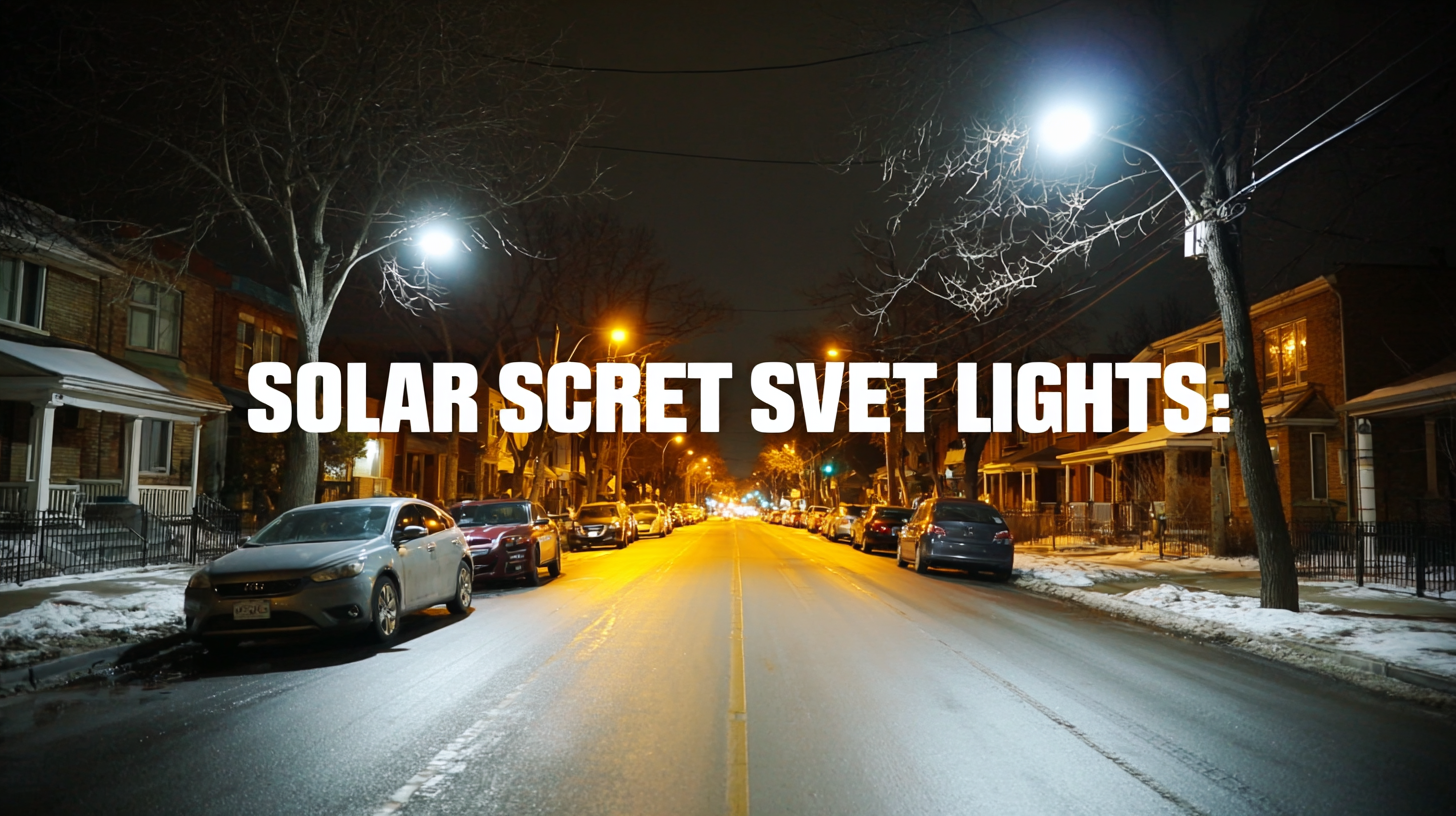News
Advantages of Choosing the Most Efficient Solar Street Lights
The global demand for efficient and sustainable energy solutions has surged, particularly in the realm of urban infrastructure, where Solar Street Lights play a pivotal role. According to a recent report by MarketsandMarkets, the solar street lighting market is projected to reach USD 18.5 billion by 2026, expanding at a CAGR of 24.5% from 2021. This growth is driven by the increasing need for eco-friendly lighting solutions and the rising awareness of the benefits of renewable energy. Solar Street Lights not only reduce dependency on conventional electricity sources but also significantly lower maintenance costs and enhance public safety. As countries like China lead the way in innovation and production, they are setting a benchmark for quality that resonates in global markets. By choosing the most efficient Solar Street Lights, cities worldwide can achieve an optimal balance of environmental stewardship and enhanced public infrastructure, paving the way for a greener future.

Key Technical Specifications to Consider for Solar Street Lights
When selecting solar street lights, several key technical specifications can significantly influence their efficiency and overall performance. One of the most critical factors is the brightness level, often measured in lumens. According to the U.S. Department of Energy, efficient solar street lights should deliver at least 1,500 to 2,500 lumens to effectively illuminate roadways and pathways. This ensures visibility while enhancing safety for pedestrians and drivers alike.
Another vital specification is the battery capacity, which determines how long the lights can operate on a single charge. A report from the National Renewable Energy Laboratory emphasizes that solar street lights should incorporate lithium-ion batteries with a capacity of at least 20Ah to ensure continuous operation throughout the night, especially in areas with prolonged cloudy conditions. Additionally, the solar panel efficiency, which should ideally exceed 20%, plays a crucial role in harnessing solar energy effectively, contributing to the longevity and reliability of the lighting system. These technical specifications are essential for ensuring that solar street lights not only meet illumination needs but also perform efficiently over time.
Advantages of Choosing the Most Efficient Solar Street Lights - Key Technical Specifications to Consider for Solar Street Lights
| Specification | Details |
|---|---|
| Light Source | LED (Light Emitting Diode) |
| Lumens Output | 1000 - 15000 lumens |
| Battery Type | Lithium-ion or Lithium-phosphate |
| Solar Panel Efficiency | 18% - 22% |
| Charge Time | 6 - 8 hours |
| Runtime | 12 - 36 hours |
| Material | Aluminum or Stainless Steel |
| Weather Resistance | IP65 or higher |
| Lighting Modes | Motion Sensor, Dusk to Dawn, Scheduled |
How to Choose the Right Solar Street Light for Your Needs
When selecting the right solar street light for your needs, it’s essential to consider several key factors that can greatly influence performance and efficiency. First, assess the brightness level you require, which is typically measured in lumens. Depending on the area you need to illuminate, choosing a unit with adjustable brightness can provide flexibility and energy savings.
Tip: Evaluate the area’s existing light conditions and determine the appropriate lumen output needed for visibility without causing excess light pollution.
Next, focus on solar panel quality and battery capacity, as these directly affect the longevity and reliability of your street lights. High-quality solar panels will harness sunlight more effectively, ensuring your lights remain operational even during cloudy days. Additionally, a battery with sufficient capacity and a good charge-discharge cycle is crucial for maintaining consistent performance.
Tip: Look for solar street lights with durable batteries and consider models that offer options for upgrades or replacements to extend their lifespan.
Lastly, consider the design and installation process. Some lights come with easy installation features, while others may require professional assistance. If DIY installation is preferred, ensure that the design is user-friendly and comes with clear instructions.
Tip: Research and compare various designs to find a model that suits your aesthetic preferences while still delivering performance.

Benefits of Using High-Efficiency Solar Street Lights
High-efficiency solar street lights offer numerous benefits that make them an ideal choice for modern urban planning. Firstly, these lights utilize advanced solar panel technology that maximizes energy capture and storage, ensuring consistent illumination throughout the night. By harnessing sunlight, they reduce reliance on traditional electricity sources, leading to significant savings in energy costs. This green energy solution not only cuts expenses but also decreases the carbon footprint associated with conventional street lighting.
Moreover, the longevity and durability of high-efficiency solar street lights contribute to their appeal. Constructed from robust materials, these lights are designed to withstand harsh weather conditions and require minimal maintenance. This resilience translates to lower replacement costs and fewer resources used over time. Additionally, their ability to operate independently of the grid enhances energy security and ensures reliable lighting in remote locations, promoting safety and accessibility in all areas.
By investing in high-efficiency solar street lights, communities can enjoy a sustainable and economical lighting solution that benefits both the environment and local residents.
Installation Tips for Maximizing Solar Street Light Performance
When installing solar street lights, proper placement is crucial to maximize their performance. Start by selecting locations with ample sunlight exposure throughout the day, avoiding areas with overshadowing trees or buildings. Ideally, the lights should be positioned to receive direct sunlight for at least six hours daily, ensuring that the solar panels can fully charge the batteries. Additionally, consider the angle of the solar panels; adjusting them to the correct tilt can enhance energy absorption, depending on your geographic location.
Another important tip is to choose the right illumination settings based on the surrounding environment. For instance, residential areas may require softer lighting to create a welcoming atmosphere, while streets with higher traffic may need brighter options for increased safety. It's also beneficial to install solar street lights at heights that optimize their brightness while minimizing obstructions. Regular maintenance checks, such as cleaning the solar panels and ensuring the lighting fixtures remain unobstructed, will help sustain their efficiency and longevity. By paying attention to these installation tips, you can significantly enhance the performance and reliability of solar street lights.
Maintenance Best Practices for Long-Lasting Solar Street Lights
 Maintaining solar street lights properly is crucial for ensuring their longevity and efficiency. According to the Solar Energy Industries Association (SEIA), regular maintenance can extend the lifespan of solar street lights up to 25 years, significantly longer than traditional street lighting systems. This longevity is primarily due to the absence of wires or delicate components that are prone to wear and tear. Implementing a routine maintenance schedule that includes cleaning solar panels, checking for loose components, and monitoring battery health is essential. Research indicates that neglecting these practices can reduce the efficiency of solar panels by up to 25%, diminishing their performance and increasing unnecessary costs.
Maintaining solar street lights properly is crucial for ensuring their longevity and efficiency. According to the Solar Energy Industries Association (SEIA), regular maintenance can extend the lifespan of solar street lights up to 25 years, significantly longer than traditional street lighting systems. This longevity is primarily due to the absence of wires or delicate components that are prone to wear and tear. Implementing a routine maintenance schedule that includes cleaning solar panels, checking for loose components, and monitoring battery health is essential. Research indicates that neglecting these practices can reduce the efficiency of solar panels by up to 25%, diminishing their performance and increasing unnecessary costs.
Moreover, keeping the surrounding areas of solar street lights clear of foliage and debris is another best practice that can enhance efficiency. A report by the International Renewable Energy Agency (IRENA) suggests that ensuring clear access to sunlight can improve the energy collection efficiency significantly. Additionally, using advanced battery management systems (BMS) can optimize energy usage and extend battery life, making systems even more reliable. By adopting these maintenance best practices, municipalities can maximize the benefits of solar street lights, reducing operational costs and contributing to sustainable urban infrastructure.
